Easy, Breezy, Beautiful…Euphyllia
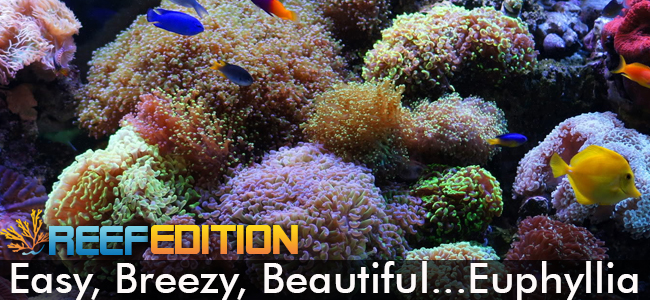
The genus Euphyllia contains some of the most spectacular and recognizable corals we’ve come to love in the marine aquarium hobby. They fall under the hobby coined term, “LPS”, or Large Polyp Stony corals. While the term LPS can shed some light on their overall care, all corals should be looked at closer than that in order to determine if they’re a good fit for your aquarium.
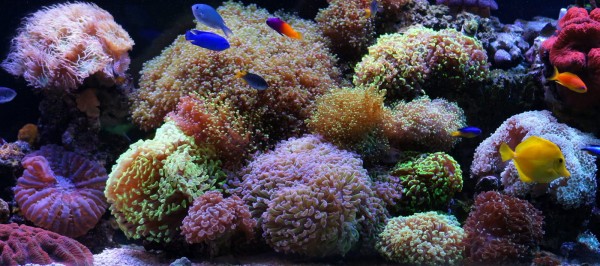
Great example of a gorgeous Euphyllia garden. Credit: Ninjapotamus
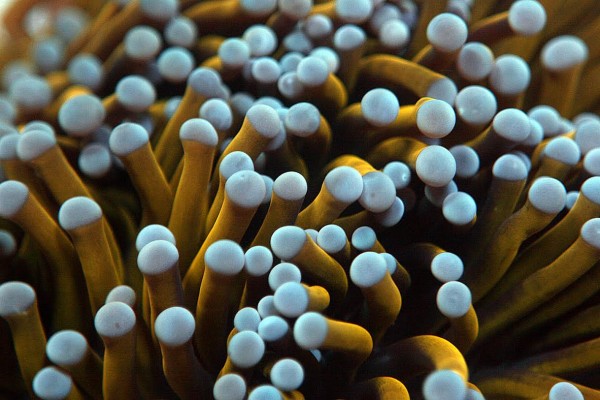
- E. glabrescens (torch). Credit: sherita
Euphyllia can be found in a dizzying array of colors, and several commonly found growth types. The skeletons grow in two main formations referred to as wall (flabello-meandroid) or branching (phaceloid). The genus offers five frequently encountered species in the trade: E. divisia (frogspawn), E. paradivisia (branching frogspawn), E. ancora (hammer), E. paraancora (branching hammer) and E. glabrescens (torch). More recently we’ve seen a couple other species being offered including E. yaeyamaensis and E. cristata.
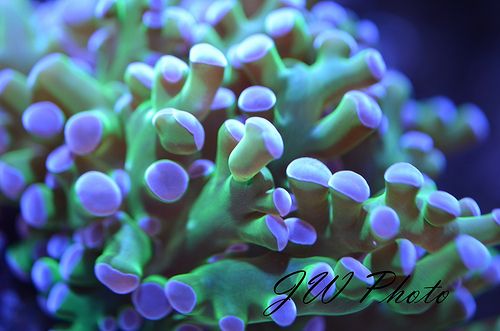
E. paradivisia (branching frogspawn). Credit: Reef Fever
Luckily for aquarists all the species will thrive under quite similar care. While most specimens could remain healthy in a vast array of conditions, they’ll all do best long term being kept in pristine water with stable parameters. Proper lighting is crucial in order for these corals to photosynthesize, although they do not have to be blasted with the brightest of lights. Suffice to say that moderate to high lighting, once acclimated to your specific light system, will ensure these corals grow quickly. Euphyllia spp. provide the ultimate “flowing” motion when kept in an alternating current, which also ensures best health for the coral.
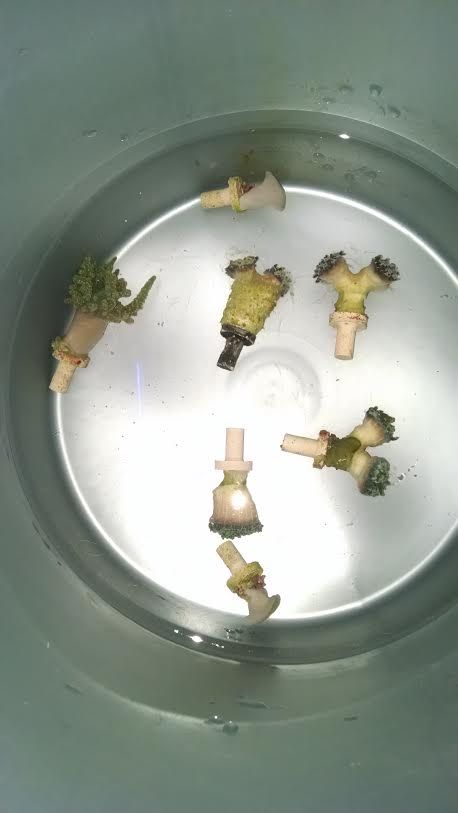
Various E. paradivisia frags being dipped prior to quarantine. Credit: Austin Lefevre
As with any other coral, hitchhiking pests should be a real concern. In my experience various flatworms and parasitic snails have been the main perpetrators. Right out of the bag I place the coral into a mix of fresh saltwater and coral dip (e.g. Revive, Bayer, RPS All Out). My go-to dip is Revive with a splash of Hikari Prazipro as an added kick in the rear to any freeloading flatworms. Once instructed dip time has surpassed I remove the coral and scrub the base vigorously with a toothbrush, quickly followed by placing into a container with fresh saltwater to rinse. The coral is then moved into quarantine to be observed prior to being added to any display aquariums. Although infrequent, I have had pests sneak past the initial dip. In my experience [at this time] there are no dips that will kill all pests and their eggs, no matter the manufacturer’s claims. A quarantine period for observation can relieve you of many headaches down the road.
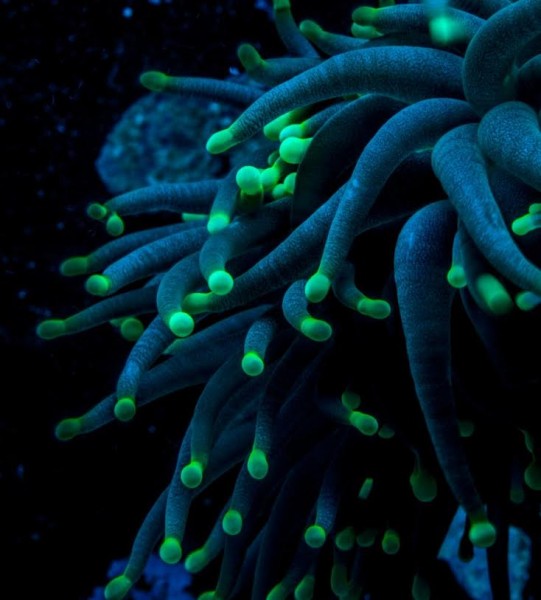
E. glabrescens (torch). Credit: thartsock
Euphyllia tentacles are incredibly beautiful little war machines. Nematocysts within each tentacle ward off nearby corals allowing the Euphyllia colony to establish its own territory. This means they need to be kept away from other types of corals, and sometimes each other. Generally all Euphyllia spp. can be kept within close proximity to one another, with the exception being E. glabrescens (torch coral). While this is a good general rule, I have witnessed oddities. Your best bet is to put colonies/fragments close to one another temporarily and observe. If they’re not going to get along you’ll know quickly as the victim of the ordeal will remain retracted until moved. Many polyps will also house one or several sweeper tentacles that can outstretch normal tentacle lengths by up to three times. In a tightly packed aquarium I prefer to keep them towards the edge of the rockwork with laminar current pushing tentacles away from other corals.
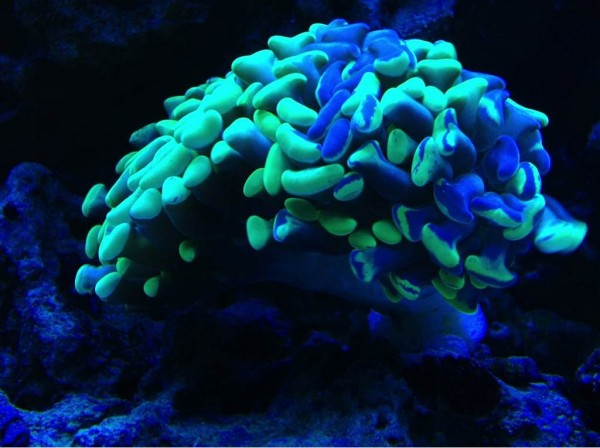
E. paraancora (branching hammer). Credit: weaponsofmassdesign
Although Euphyllia spp. can survive solely through photosynthesis they will accept a myriad of meaty food items ranging from baby brine shrimp all the way up to live guppies. However I just let them photosynthesize and catch what they can out of the water column (e.g. fish waste, detritus, excess foods). I have not personally witnessed Euphyllia spp. growing at a faster rate while being directly fed.
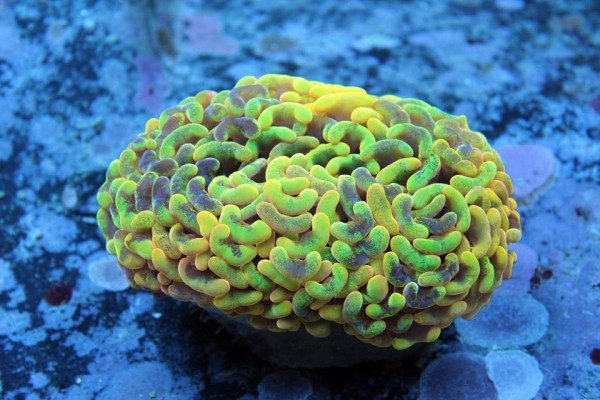
The one and only tricolor Euphyllia I’ve ever seen, sporting gold, green and yellow on this wonderful E. ancora. Credit: Ultra Coral Australia
Once thriving, Euphyllia spp. grow surprisingly quickly. A small one polyp fragment can grow into a fist sized colony within one year. That fist sized colony can grow into a basketball sized colony within two more. They’ve also proven fairly easy to fragment, particularly the branching species. All of the above makes this genus a great choice for many professional coral farmers. The industry standard coral band saws (e.g. Inland, Gryphon, Studio Pro) make perfect frags with ease, although you can go medieval with a pair of side cutters for branching species or chisel and hammer for wall formations. I must say that most wall specimens do not take fragging overly well unless performed with precision on a thriving colony.
Overall Euphyllia spp. are some of my personal favorites and make superb aquarium candidates. Nowadays it’s not overly difficult to find numerous color options in one place allowing you to create a phenomenally diverse Euphyllia garden of your own. Success with these corals is generally high making them even more enjoyable than some of their more difficult “LPS” counterparts.
For all the latest LPS posts and topics please visit our forum here.
Comments are closed.
